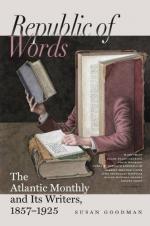The Temple Square is in the immediate neighborhood, and is of the same size. It is inclosed by a wall even more massive than the others, plastered and divided into panels. Near its southwestern corner stands the Tabernacle, a long, one-storied building, with an immense roof, containing a hall which will hold three thousand people. There the Mormon religious services are conducted during the winter months; but throughout the summer the usual place of gathering to listen to the sermons is in “boweries,” so called, which are constructed by planting posts in the ground and weaving over them a flat roof of willow-twigs. An excavation near the centre of the square, partially filled with dirt previously to the exodus to Provo, marks the spot where the Temple is to rise. It is intended that this edifice shall infinitely surpass in magnificence its predecessor at Nauvoo. The design purports to be a revelation from heaven, and, if so, must have emanated from some one of the Gothic architects of the Middle Ages whose taste had become bewildered by his residence among the spheres; for the turrets are to be surmounted by figures of sun, moon, and stars, and the whole building bedecked with such celestial emblems. Only part of the foundation-wall has yet been laid, but it sinks thirty feet deep and is eight feet broad at the surface of the ground. Its length, according to the heavenly plan, is to be two hundred and twenty feet, and its width one hundred and fifty feet. Beside the Tabernacle and the incipient Temple, the only considerable building within the square is the Endowment-House, where those rites are celebrated which bind a member to fidelity to the Church under penalty of death, and admit him to the privilege of polygamy.
The other principal buildings within the city are the Council-House, a square pile of sandstone, once used as the Capitol,—and the County Court-House, yet unfinished, above which rises a cupola covered with tin. Most of the houses in the immediate vicinity of Young’s are two stories high, for that is the aristocratic quarter of the town. In the outskirts, however, they never exceed one story, and resemble in dimensions the innumerable cobblers’-shops of Eastern Massachusetts.
None of the streets have names, except those which bound the Temple Square and are known as North, South, East, and West Temple Streets, and also the broad avenue which receives the road from Emigration Canon and is called Emigration Street. Except on East Temple or Main Street, which is the business street of the city, the houses are all built at least twenty feet back from the sidewalk, and to each one is attached a considerable plot of ground. There is no provision for lighting the streets at night. The cotton-wood trees along the borders of the gutters have attained a considerable growth during the eight or nine years since they were planted, and afford an agreeable shade to all the sidewalks.
Around a great portion of the city stretches a mud wall with embrasures and loopholes for musketry, which was built under Young’s direction in 1853, ostensibly to guard against Indian attacks, but really to keep the people busy and prevent their murmuring. To the east of this runs a narrow canal, which was dug by the voluntary labor of the Saints, nearly fifteen miles to Cottonwood Creek, for the transportation of stone to be used in building the Temple.




